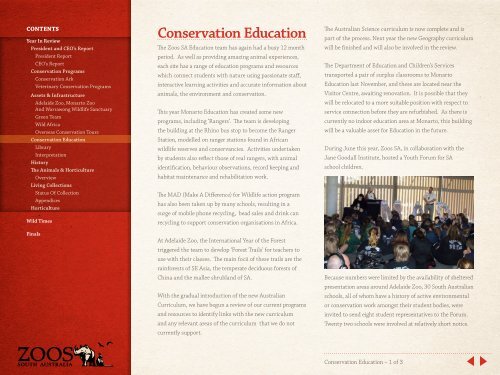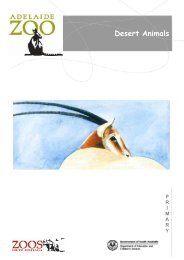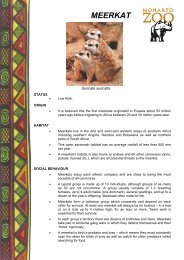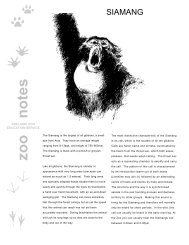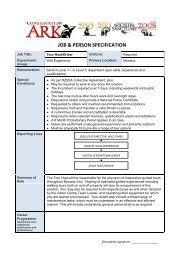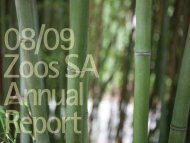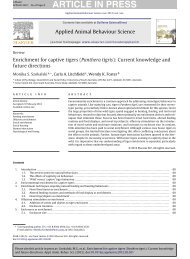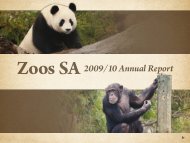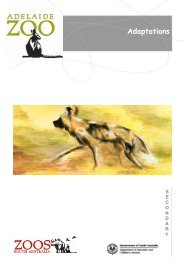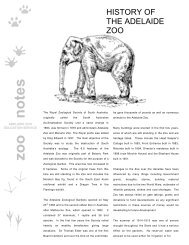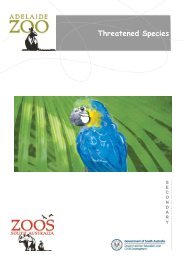2010 - 2011 Annual Report - Zoos South Australia
2010 - 2011 Annual Report - Zoos South Australia
2010 - 2011 Annual Report - Zoos South Australia
You also want an ePaper? Increase the reach of your titles
YUMPU automatically turns print PDFs into web optimized ePapers that Google loves.
CONTENTSYear In ReviewPresident and CEO’s <strong>Report</strong>President <strong>Report</strong>CEO’s <strong>Report</strong>Conservation ProgramsConservation ArkVeterinary Conservation ProgramsAssets & InfrastructureAdelaide Zoo, Monarto ZooAnd Warrawong Wildlife SanctuaryGreen TeamWild AfricaOverseas Conservation ToursConservation EducationLibraryInterpretationHistoryThe Animals & HorticultureOverviewLiving CollectionsStatus Of CollectionAppendicesHorticultureWild TimesFinalsConservation EducationThe <strong>Zoos</strong> SA Education team has again had a busy 12 monthperiod. As well as providing amazing animal experiences,each site has a range of education programs and resourceswhich connect students with nature using passionate staff,interactive learning activities and accurate information aboutanimals, the environment and conservation.This year Monarto Education has created some newprograms, including ‘Rangers’. The team is developingthe building at the Rhino bus stop to become the RangerStation, modelled on ranger stations found in Africanwildlife reserves and conservancies. Activities undertakenby students also reflect those of real rangers, with animalidentification, behaviour observations, record keeping andhabitat maintenance and rehabilitation work.The MAD (Make A Difference) for Wildlife action programhas also been taken up by many schools, resulting in asurge of mobile phone recycling, bead sales and drink canrecycling to support conservation organisations in Africa.At Adelaide Zoo, the International Year of the Foresttriggered the team to develop ‘Forest Trails’ for teachers touse with their classes. The main focii of these trails are therainforests of SE Asia, the temperate deciduous forests ofChina and the mallee shrubland of SA.With the gradual introduction of the new <strong>Australia</strong>nCurriculum, we have begun a review of our current programsand resources to identify links with the new curriculumand any relevant areas of the curriculum that we do notcurrently support.The <strong>Australia</strong>n Science curriculum is now complete and ispart of the process. Next year the new Geography curriculumwill be finished and will also be involved in the review.The Department of Education and Children’s Servicestransported a pair of surplus classrooms to MonartoEducation last November, and these are located near theVisitor Centre, awaiting renovation. It is possible that theywill be relocated to a more suitable position with respect toservice connection before they are refurbished. As there iscurrently no indoor education area at Monarto, this buildingwill be a valuable asset for Education in the future.During June this year, <strong>Zoos</strong> SA, in collaboration with theJane Goodall Institute, hosted a Youth Forum for SAschool children.Because numbers were limited by the availability of shelteredpresentation areas around Adelaide Zoo, 30 <strong>South</strong> <strong>Australia</strong>nschools, all of whom have a history of active environmentalor conservation work amongst their student bodies, wereinvited to send eight student representatives to the Forum.Twenty two schools were involved at relatively short notice.Conservation Education – 1 of 3


